
The Winnipeg Blue Bombers are a professional Canadian football team based in Winnipeg, Manitoba. The Blue Bombers compete in the Canadian Football League (CFL) as a member club of the league's West division. They play their home games at IG Field.
The West Division is one of the two regional divisions of the Canadian Football League (CFL), its counterpart being the East Division.

Donald Henderson Bain was a Canadian amateur athlete and merchant. Though he competed and excelled in numerous sports, Bain is most notable for his ice hockey career. While a member of the Winnipeg Victorias hockey team from 1894 until 1902, Bain helped the team win the Stanley Cup as champions of Canada three times. A skilled athlete, he won championships and medals in several other sports and was the Canadian trapshooting champion in 1903. In recognition of his play, Bain was inducted into a number of halls of fame, including the Hockey Hall of Fame in 1949. He was also voted Canada's top athlete of the last half of the 19th century.

Gerald Sydney Halter, was a Canadian sports executive and lawyer. He served as the first commissioner of the Canadian Football League from 1958 to 1966, and was president of the Amateur Athletic Union of Canada from 1938 to 1946.

William Abraham Hewitt was a Canadian sports executive and journalist, also widely known as Billy Hewitt. He was secretary of the Ontario Hockey Association (OHA) from 1903 to 1966, and sports editor of the Toronto Daily Star from 1900 to 1931. He promoted the establishment of the Canadian Amateur Hockey Association (CAHA), then served as its secretary-treasurer from 1915 to 1919, registrar from 1921 to 1925, registrar-treasurer from 1925 to 1961, and a trustee of the Allan Cup and Memorial Cup. Hewitt standardized player registrations in Canada, was a committee member to discuss professional-amateur agreements with the National Hockey League, and negotiated working agreements with amateur hockey governing bodies in the United States. He oversaw referees within the OHA, and negotiated common rules of play for amateur and professional leagues as chairman of the CAHA rules committee. After retiring from journalism, he was the managing-director of Maple Leaf Gardens from 1931 to 1948, and chairman of the committee to select the inaugural members of the Hockey Hall of Fame in 1945.

Claude Copeland Robinson was a Canadian ice hockey and sports executive. After winning an intermediate-level championship as captain of the Winnipeg Victorias in 1905, he served as secretary-treasurer and as vice-president of the Victorias. He coached the Victorias to a Manitoba Hockey League championship in 1909, and felt that his team could have competed for the newly established Allan Cup, despite that challenges from senior ice hockey teams were accepted only from Eastern Canada at the time. The Victorias won the Allan Cup by default in 1911, when the Toronto St. Michael's Majors refused to play, then successfully defended four challenges for the trophy.
Manitoba Rugby Football Union was a Canadian football league, founded on Monday February 22, 1892. The league merged with the Alberta Rugby Football Union and Saskatchewan Rugby Football Union to form the Western Canada Rugby Football Union on Saturday October 21, 1911.
The Winnipeg Rugby Football Club was a Canadian football team in Winnipeg, Manitoba that played in the Manitoba Rugby Football Union between 1892 and 1906. The team was originally founded in 1879, was the first club in Manitoba, and played in the Manitoba Rugby League, the forerunner to the MRFU which was founded in 1892. They were 3 time league champions.
Arthur "Bert" Warwick was a Canadian Football League head coach, league executive, and a member of the Canadian Football Hall of Fame.

Winnipeg Rowing Club (WRC) is a rowing club on the Red River in downtown Winnipeg, Manitoba.

The Winnipeg Rifles are a Canadian football team based in Winnipeg, Manitoba. The Rifles are members of the Canadian Junior Football League and play their home games in Maple Grove Park.

Sylvester Patrick "Silver" Quilty was a Canadian football player, referee, coach and sport administrator. As a player, he won the Yates Cup in 1907 with the Ottawa Gee-Gees football team, and was credited as the first man to play the flying wing position. He also played with the Ottawa Rough Riders, and the McGill Redmen football team. After his playing career, he became a football referee and officiated the 10th Grey Cup, and also coached the Ottawa Rough Riders.
Brian Mercer "Old Man of the Mountain" Timmis was a star senior Canadian football player in the Saskatchewan Rugby Football Union (SRFU) and Interprovincial Rugby Football Union (IRFU) for a combined 17 seasons, mainly for the Hamilton Tigers. He is a three-time Grey Cup champion as a player, having won with the Tigers in 1928, 1929, and 1932. He later coached the Hamilton Flying Wildcats, leading them to the 1943 Grey Cup championship. He was an inaugural member of the Canadian Football Hall of Fame in 1963 and was also inducted into Canada's Sports Hall of Fame in 1975. Brian Timmis Stadium in Hamilton, Ontario was named after him.
The 1906 Canadian football season was the 15th season of organized play since the Canadian Rugby Union (CRU) was founded in 1892 and the 24th season since the creation of the Ontario Rugby Football Union (ORFU) and the Quebec Rugby Football Union (QRFU) in 1883. The season concluded with the Hamilton Tigers defeating the McGill University Seniors in the 1906 Dominion Championship game.
The Winnipeg Monarchs were a Canadian junior ice hockey team that competed in the Manitoba Junior Hockey League from 1930 to 1978.

John Welch Hamilton was a Canadian sports executive. He served as president of the Canadian Amateur Hockey Association (CAHA) from 1930 to 1932, president of the Amateur Athletic Union of Canada from 1936 to 1938, and was a member of the Canadian Olympic Committee for 17 years. His leadership of the CAHA and the AAU of C coincided with efforts to maintain amateurism and combat growing professionalism in sport. He appointed a committee to establish better relations between the CAHA and professional leagues, and praised the players and teams for quality hockey and growth of the amateur game in Canada despite the competition. He favoured professionals in one sport playing as amateurs in another, and took charge of the AAU of C at a time when the CAHA, the Canadian Amateur Basketball Association, and the Canadian Amateur Lacrosse Association challenged the definition of amateur, and later broke away from the AAU of C which wanted to hold onto purist ideals of amateurism.
The Winnipeg Tammany Tigers football team was a Canadian football team in Winnipeg, Manitoba that played in the Manitoba Rugby Football Union and Western Canada Rugby Football Union between 1913 and 1929. On May 14, 1930, the Tammany Tigers disbanded due to financial difficulties and a month later was reorganized as a new team: the Winnipegs. The team was part of one of the most successful and popular sports clubs in the city, the Tammany Tigers Athletic Association, which also fielded championship lacrosse, baseball and ice hockey teams.
The Victoria Rugby Club, popularly known as the Winnipeg Victorias, was a Canadian football team in Winnipeg, Manitoba that played in the Manitoba Rugby Football Union and Western Canada Rugby Football Union between 1915 and 1935. The Winnipeg Victorias formed in the summer of 1915 when they took over the Winnipeg Rowing Club football team. The Victorias were a new team, as the Rowing Club continued to operate, naturally, as a rowing club. Prior the 1915 season the Victorias announced that they would not have a senior team, but did have teams at the intermediate, junior and juvenile levels. In 1924 they were first Winnipeg team to qualify for the Grey Cup. "An internal disagreement over which railway to use ended up costing the team the right to play. The Victorias chose to suspend operations rather than join the new Tri-City Football League. Concern over travel expenses was the reason."








